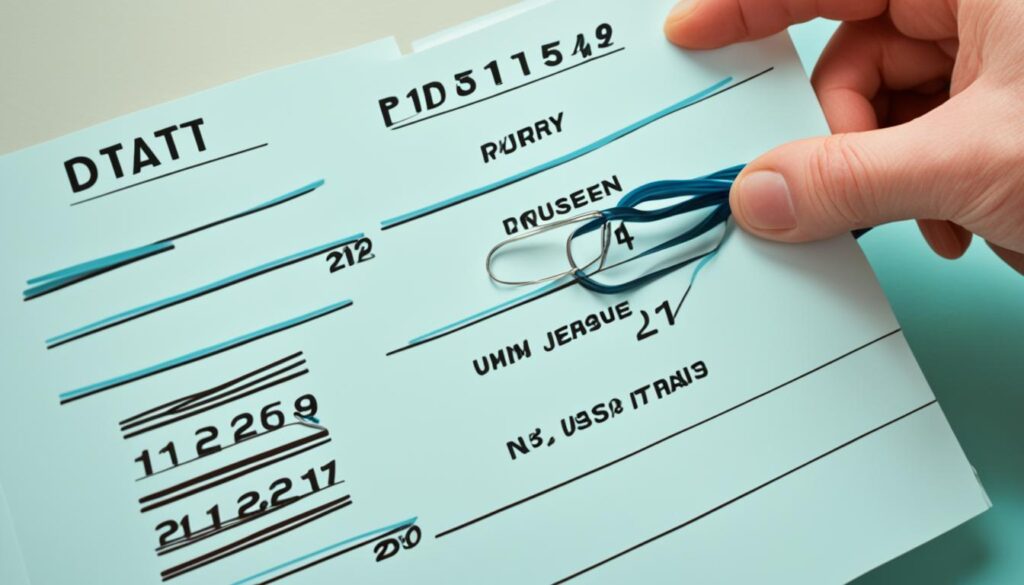Dealing with a high monthly loan payment can be tough. But, there are ways to cut down your payments and ease the financial strain. This article will cover strategies like income-driven plans, consolidating loans, refinancing, and getting help with repayment. These methods can help you lower your monthly payments and better your financial health.
Key Takeaways
- Understand the importance of lowering your monthly loan payments to improve your financial situation.
- Explore income-driven repayment plans that base your monthly payments on your income and family size.
- Consider consolidating your loans to simplify repayment and potentially lower your interest rate.
- Investigate the process of refinancing your loan to secure a lower interest rate and monthly payment.
- Utilize loan repayment assistance programs offered by the government or your employer to reduce your debt burden.
Understanding the Importance of Lowering Monthly Loan Payments
High monthly loan payments can be a big financial strain. They leave you with little money for other important costs. This can make it hard to save for emergencies or improve your life quality.
Lowering your monthly loan repayment can bring financial relief. It lets you use more of your income for other goals. Goals like saving for emergencies, investing, or living better.
The Burden of High Monthly Payments
Carrying a heavy loan repayment burden can make managing money tough. A big part of your income goes to loan payments. This leaves little for rent, utilities, food, and healthcare.
This can cause stress, make saving hard, and even lead to missing payments.
Benefits of Reducing Loan Repayment Amounts
Lowering your monthly loan payments has big benefits, including:
- Improved budgeting and cash flow – Smaller payments make it easier to manage your money. You can focus on other financial goals and avoid late payments.
- Increased financial flexibility – With lower monthly loan payments, you have more money for saving, investing, or a better life.
- Reduced stress and anxiety – Lessening the loan repayment burden can make you feel less stressed and improve your well-being.
Understanding how lowering your monthly loan payments helps, you can take steps for better financial relief. This gives you more control over your financial future.
Explore Income-Driven Repayment Plans
If you’re struggling with high monthly payments on your federal student loans, income-driven repayment (IDR) plans might help. These plans set your monthly payment as a percentage of your income. This can make your payments much lower.
What are Income-Driven Repayment Plans?
There are four main IDR plans for federal student loans: Income-Based Repayment (IBR), Income-Contingent Repayment (ICR), Pay As You Earn (PAYE), and Revised Pay As You Earn (REPAYE). Each plan aims to lower your monthly payments if you have a lower income.
Eligibility Criteria and Application Process
To get an IDR plan, you need federal student loans and show you’re facing a financial hardship. This means your standard 10-year payment is more than you can afford with your income and family size. You’ll need to provide income and family size documents. You might also need to update your info every year to keep getting lower payments.
Looking into IDR plans can help you lower your student loan payments. By learning about the different plans and what you need for them, you can find the best one for your finances. This way, you can pay as you earn with a smaller monthly payment.
Consolidate Your Loans

If you’re struggling with many monthly loan payments, consolidating your loans could change everything. Loan consolidation means combining several loans into one. This can lead to a lower interest rate and a longer repayment term. You might see your monthly payment drop, making it easier on your wallet and simplifying your finances.
Combining your loans into one can bring many benefits. Reducing monthly payments gives you more room in your budget for savings or paying off high-interest debt. It also makes keeping track of payments easier, lowering the chance of missing or being late with payments.
To look into loan consolidation, follow these steps:
- Collect details about your current loans, like balances, interest rates, and repayment terms.
- Look into different consolidation options, such as federal or private loan consolidation.
- Check how much you could save with lower monthly payments and the loan’s total cost over time.
- Make sure the new loan’s terms meet your financial goals and needs.
| Loan Type | Average Interest Rate | Average Monthly Payment | Average Repayment Term |
|---|---|---|---|
| Federal Student Loans | 5.8% | $393 | 10 years |
| Private Student Loans | 7.5% | $450 | 10 years |
| Personal Loans | 9.4% | $320 | 5 years |
By consolidating your loans, you could get a lower interest rate and a longer repayment term. This means a more manageable monthly payment. It’s a smart way to streamline loan payments and improve your financial future.
Refinance Your Loan
Refinancing your loan can help lower your monthly payments. By working with a private lender, you might get a lower interest rate. This can mean a smaller monthly payment. You could also choose to extend the repayment term, making payments even smaller. But, this might mean paying more interest over time.
Understanding the Refinancing Process
Refinancing means getting a new loan to pay off your old one. This new loan could have better terms, like a lower interest rate or a longer time to pay back. To refinance, you must meet the lender’s credit and income standards. You’ll also need to provide details about your current loan and finances.
Potential Savings from Refinancing
Figuring out the potential savings from refinancing is key. A lower interest rate and a longer loan term could greatly reduce your monthly payments. This could save you a lot over the loan’s life. But, remember to look at the new loan’s total cost, including fees and closing costs. Make sure the long-term gains are worth the upfront costs.
- Evaluate your current loan terms and interest rate
- Research and compare refinancing options from multiple lenders
- Calculate the potential savings in monthly payments and overall interest paid
- Consider the impact of extending the loan term on the total cost of the loan
“Refinancing can be a powerful tool to reduce your monthly loan payments and potentially save you thousands of dollars over the life of the loan.”
Consider Loan Repayment Assistance Programs
If you’re finding it hard to manage your loan payments, help might be available. Programs at the state, federal, and employer levels can ease your financial load. They can make your loan payments much lighter.
State and Federal Assistance Programs
States and the federal government offer aid for certain careers or situations. Teachers, healthcare workers, and those in public service might get help with loan forgiveness or repayment. Look into these programs to see if you qualify and could lower or wipe out your payments.
Employer-Sponsored Loan Repayment Assistance
Some jobs come with extra perks like help with loan repayment. This is great for new grads or those in entry-level positions. Employers might pay part of your loan or offer bonuses to speed up your debt repayment. Always ask about such benefits when looking for a job or talking to your current employer.
Exploring loan repayment programs can seem overwhelming, but the benefits are huge. By looking into your options, you could lessen your loan debt and boost your financial health.
Extend the Loan Repayment Term

Extending your loan’s repayment term can lower your monthly payments. This means spreading your loan over 20 or 25 years instead of 10. It helps ease your budget by making payments smaller.
But, there are downsides to consider. A longer loan term means you’ll pay more interest over time. This happens because interest is added for a longer period, making the total cost higher.
Before you decide, think about how it affects your finances. Compare the lower monthly payments with the higher total interest. This will help you choose wisely for your financial future.
Extending your loan term can help reduce your monthly payments. But, make sure you understand the long-term effects. It’s key to see if it’s right for your financial situation.
“Loan Repayment” Strategies
Looking into ways to pay off your loan faster can help you save money. Here are three strategies you can use:
Make Bi-Weekly Payments
Try making payments every two weeks instead of monthly. This means you’ll pay the same as an extra month each year. It’s a simple way to shorten the loan term and save on interest.
Round Up Monthly Payments
Round up your monthly payments to the nearest $50 or $100. This small extra amount can make a big difference over time. It reduces the loan term and the total interest you pay.
Make an Extra Payment Annually
If extra monthly payments are hard, consider one big payment each year. This can shorten your loan term and save on interest. It’s a powerful way to get out of debt faster.
Using these strategies can help you lower your monthly payments, shorten the loan term, and save on interest. Every bit helps in becoming debt-free.
Tips for Budgeting and Increasing Income

Looking at your budget and finding ways to make more money is key. Review your spending and see where you can spend less. This can help you save money for your loan payments. Also, finding a side job or other ways to earn more can give you the extra cash to pay off your loan faster. This means you’ll pay less interest over time.
Cutting Expenses to Free Up Funds
It can be tough to budget for loan payments, but looking closely at your spending can help. Here are some tips to save money:
- Look at your spending on things you don’t really need, like eating out, subscription services, or entertainment.
- Try to get a better deal on bills like cable, internet, or gym memberships by negotiating or canceling them.
- Find ways to use less energy at home, like setting your thermostat lower, using efficient appliances, or getting discounts.
Side Hustles and Additional Income Sources
Boosting your income can help you pay off your loan faster. Here are some ways to make more money:
- Use your skills for freelance or consulting work in your area of expertise.
- Start a small business, like an online store, pet sitting, or virtual assistant service.
- Try out gigs like driving for a ride-share service, delivering food, or renting out a room on a short-term basis.
By cutting expenses and earning more, you can pay more towards your loan. This will lower the total cost of your debt and help you become debt-free faster.
Also Read: What Are Construction Loans And How Do They Work?
| Expense Reduction Strategies | Additional Income Sources |
|---|---|
|
|
“Budgeting and increasing your income can be powerful tools in your quest to lower your monthly loan repayments and achieve financial freedom.”
Conclusion
There are many ways to lower your monthly loan payments and improve your finances. You can look into income-driven repayment plans and loan consolidation. Refinancing, extending your repayment term, and using personal tactics can also help.
By using these summary of loan repayment strategies, you can cut down on your payments. This helps you get closer to being debt-free. Adding budgeting and ways to increase your income can make managing loans easier.
Finding the right mix of strategies is key to reducing your debt. Keep looking at your options and stick to your goal of becoming debt-free. With hard work and a good financial plan, you can take back control of your money. This will lead you to a brighter future.
FAQs
Q: How can I lower my monthly loan repayment?
A: You can lower your monthly loan repayment by exploring different repayment plans available for your student loan. Contact your loan servicer to discuss options such as a fixed payment repayment plan or income-driven repayment plans.
Q: What is a student loan repayment program?
A: A student loan repayment program is a structured plan designed to help borrowers repay their student loans in a manageable way. These programs may offer various repayment options and benefits based on the borrower’s specific circumstances.
Q: What is a loan servicer?
A: A loan servicer is a company that handles billing and other services on federal student loans. They are the primary point of contact for borrowers regarding loan repayment and manage the loan account on behalf of the lender or the Department of Education.
Q: How can I qualify for loan forgiveness?
A: To qualify for loan forgiveness, you may need to meet specific criteria, such as working in a designated health service or public service field for a certain period of time. Programs like the Public Service Loan Forgiveness (PSLF) and Health Service Corps offer loan forgiveness options for eligible professionals.
Q: What is a fixed payment repayment plan?
A: A fixed payment repayment plan is a loan repayment option where you make consistent monthly payments of a set amount until the loan is fully paid off. This plan provides predictability in monthly payments but may result in a higher overall interest cost compared to other repayment plans.
Q: How do I contact my loan servicer?
A: You can contact your loan servicer by visiting their website, calling the customer service phone number provided on your loan statements, or logging into your online account. It’s important to communicate with your loan servicer if you have questions or need assistance with your student loan repayment.
Q: What are some repayment options available for federal student loans?
A: Repayment options for federal student loans include income-driven repayment plans, standard repayment plans, graduated repayment plans, extended repayment plans, and consolidation options like Direct Consolidation Loans. Each option has its own eligibility requirements and benefits, so it’s essential to research and choose the best option for your financial situation.
Source Links
- https://www.wellsfargo.com/goals-credit/smarter-credit/manage-your-debt/lower-monthly-payments/
- https://www.lendingtree.com/student/how-to-lower-student-loan-payments/
- https://www.horizonfcu.org/5-ways-to-pay-off-a-loan-early/